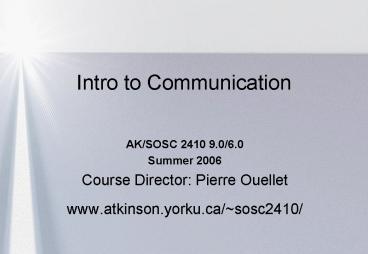Intro to Communication - PowerPoint PPT Presentation
1 / 15
Title:
Intro to Communication
Description:
From the Two-Step Flow Model. to Limited Effects Theory. Paul Lazarsfeld. and ... the two-step flow model; the decision-making process; key factors; limited ... – PowerPoint PPT presentation
Number of Views:49
Avg rating:3.0/5.0
Title: Intro to Communication
1
Intro to Communication
- AK/SOSC 2410 9.0/6.0
- Summer 2006
- Course Director Pierre Ouellet
- www.atkinson.yorku.ca/sosc2410/
2
From the Two-Step Flow Model to Limited Effects
Theory
- Paul Lazarsfeld
- and
- the Two-Step Flow Model of Communication
3
The Two-Step Flow of Communication
- Lecture Outline
- background
- Erie County voting study
- the two-step flow model
- the decision-making process
- key factors
- limited effects model
- contingency theory
- Social network theory.
4
Transmissive Model
Sender
Message
Receiver
Effect
S
M
R
R1
5
The Two-Step Flow Model
SOCIAL
Sender
Message
Receiver
Effect
S
M
R
R1
(S/N)
6
Decision-Making Process
- Exists on a continuum
- depends on two factors
- personal psyche or disposition
- the information itself.
Early Adopters
Converts
Waverers
Crystallizers
7
Key Factors in Decision-Making Process
- socio-economic status (class)
- religion
- gender
- intra-familial status.
8
Considering Other Approaches
9
Limited Effects Model
- Limited set of assumptions
- interested in specific processes
- needs to be integrated into larger theoretical
framework - is sufficiently empirical to allow for testing.
10
Contingency Theory
- Who says what to whom in what context?
- medium (choice)
- content (what is being said)
- audience (to whom?)
- context and conditions (social influences).
11
Social Network Theory
- Social network theory is an analytical model
used in the Social Sciences that considers social
relationships, at both the macro and the micro
level, in terms of nodes and ties. Nodes refer to
the individual actors within any given network
while ties represent the various relationships
between the actors. It is further understood that
a variety of different ties can and do exist
between nodes and that these are indicative of
the social capital of the various actors involved
in the network.
12
Social Network Theory
- Social capital refers to the network position
of the object or node and consists of the ability
to draw on the resources contained by members of
the network (Kadushin, C., 2003 in Ethier, J.,
Current Research in Social Networks). - Social network theory differs from traditional
sociological theory in that it considers the
relationships between individual actors of
greater significance that their attributes. In
other words, many real-world phenomena can be
explained by the nature of the relationship
(power economy influence - proximity) between
actors rather than their individual traits (smart
or dumb, friendly or unfriendly).
13
Social Network Theory
14
Social Network Theory
- By introducing the social dimension of
communication practices into the Two-Step Flow
model of communication, Lazersfeld anticipated to
more extensive and detailed project of network
analysis which has offered a productive
alternative to the more traditional approaches to
communication theory
15
Options
Home
First Slide































